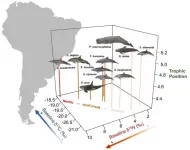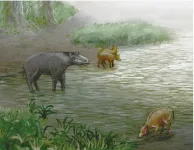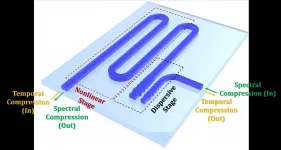(Press-News.org) Dolphin species that live together, do not necessarily compete for food
A new molecular method reveals how different species of toothed whales compete for prey and which food they choose in each other's company. Marine scientists from NIOZ recently published their work in the scientific magazine Environmental Research.
Little is still known about the food and food search behaviour of toothed whales. What we know historically, is primarily derived from the stomach content of dead specimens. However, this makes it hard to actively study them in their natural habitat: you can't do more than wait for animals to wash ashore. Consequently, proper ecological research on how various species of sea mammals influence one another in their choice for food, is quite difficult, as you cannot observe the animals at the large depths at which they hunt.
Neither top predator nor overlap in food
For this problem, researchers of the Royal NIOZ, Netherlands Institute for Sear Research, found a solution. They used so-called stable nitrogen isotopes of amino acids in small pieces of skin tissue from living sperm whales, orca and eight dolphin species in the Southwestern part of the Atlantic Ocean, off the coast of Brazil.
"It was known that there were slight differences in food preference in for example fish or squid", says researcher Marcel van der Meer. "However, according to previous research, the rough-toothed dolphin Steno bredanensis was supposed to be the absolute top predator of the area, and that is unlikely. With our amino acid isotope research, we discovered that its trophic level is indeed significantly lower than previously determined."
Apart from that, the method used before, suggested great overlap in food of three of the dolphin species. Van der Meer "We now know that there isn't any overlap whatsoever. The short-beaked common dolphin Delphinus delphis, turns out to hunt at a different depth in shallow water, while the Atlantic spotted dolphin Stenella frontalis and the common bottlenose dolphin Tursiops truncatus hunt in waters up to depths of 500 meters. The latter two species, that thus feed at the same depth, have different prey. Apparently, the dolphin species have found a way to live together without competing for food.
Correcting for the noise
In this research project, first author Genyffer Troina (Federal University of Rio Grande, Brazil) visited the NIOZ on Texel to work on her samples with Marcel van der Meer and his colleague Philip Riekenberg. It is an improvement of more commonly used isotope analysis (see frame), however uses nitrogen in free amino acids instead of in the tissue as a whole. They use the nitrogen isotopes of the amino acid phenylalanine, a building block of every living cell that, after uptake by plant eaters, is passed through the food web almost unchanged up to the level of top predators.
Using the nitrogen isotope value of this amino acid, the scientists can, as it were, determine the base value of the nitrogen in the environment. That enables them to correct for the 'noise' that is caused by an unknown living environment in which researchers cannot measure the nitrogen value themselves. By comparing the base value with the value in the sea mammal they are studying, they are able to determine the trophic level of the species, meaning what its position is in taking up the amino acids. A plant would be level one, a top predator may be level 5.
Research with stable isotopes goes roughly like this. A small part of the atoms like nitrogen (N) that occur in every living cell, is a little bit heavier than the rest. As an animal ingests the nitrogen with its food, digestion (metabolism) separates the heavy atoms a tiny bit slower than the light ones, with the result that the heavy atoms are taken up into the body tissue of the animal more often than the light version. This pattern of uptake piles up: the higher an animal is in the food web, the more heavy N-atoms in its body tissue.
However, to be able to guarantee the accuracy of the method, you must know the isotope level of the original food. In marine environments, this value - most often of algae - is difficult to determine and may also vary a lot. The amino acid isotope method solves that problem.
# END
Many standard economic models assume people make perfectly rational, individual decisions. But new research suggests economic phenomena like inequality and business cycles are better explained by models which recognize that people's decisions are affected by the decisions and the behaviors of people around them.
To show this, researchers built a model in which households are embedded in a social network that powerfully affects their savings decisions. This fairly simple model resulted in cyclical fluctuations resembling business cycles, as well as in emergent inequality - for instance, many poor households with low saving rates and a few rich households with high saving ...
* Clinical trial at University of Warwick compares the familiar cast, traditionally signed in sympathy, to modern removable brace for immobilising broken ankles
* Cast was not more effective, with patients reporting similar levels of pain and functionality, suggesting that choice should be down to patient preference and cost effectiveness
* Some data suggested a patient preference for the removable brace - sometimes referred to as the 'Beckham boot' after David Beckham
Using a cast is not more effective than a brace for treating broken ankles, according to University ...
An elegant new algorithm developed by Danish researchers can significantly reduce the resource consumption of the world's computer servers. Computer servers are as taxing on the climate as global air traffic combined, thereby making the green transition in IT an urgent matter. The researchers, from the University of Copenhagen, expect major IT companies to deploy the algorithm immediately.
One of the flipsides of our runaway internet usage is its impact on climate due to the massive amount of electricity consumed by computer servers. Current CO2 emissions ...
Medical researchers at Ludwig-Maximilians-Universitaet (LMU) in Munich have uncovered how signal proteins of the immune system regulate the development of atherosclerosis.
Atherosclerosis is one of the most common causes of death in Germany. The condition is characterized by the build-up of cholesterol and other fatty metabolites in the arterial wall directly below the endothelial cell layer, which is in direct contact with the bloodstream. This process results in constriction of the artery, which obstructs blood flow and can trigger heart attacks and strokes. Atherosclerosis is generally treated with drugs that reduce the concentration of lipids in the circulation, often using compounds called statins. However, statins effectively reduce the risk of cardiovascular ...
Dysmenorrhea, that is, frequent severe and painful cramps during menstruation from abnormal contractions of the uterus, is the most common of all gynecological disorders. It affects between 16-91% of girls and women of reproductive age, of whom 2%-29% have symptoms severe enough to restrict their daily activity. Now, for the first time, researchers from China Medical University Hospital in Taiwan have shown that long-term exposure to air pollutants such as nitrogen and carbon oxides and fine particulate matter greatly raises the risk of developing dysmenorrhea. Based on long-term data on air quality and public health from national databases, they show that the risk to develop dysmenorrhea ...
A study led by University of Barcelona researchers and carried out together with more than 1,650 students and their family members from 18 educational centres in Barcelona shows that citizen science is a valid approach able for doing high quality science, and in this case, able to provide nitrogen dioxide values with an unprecedented resolution and to assess the impact of the pollution in the health of their inhabitants.
The journal Science of the Total Environment has published the results of a study carried out by the research group OpenSystems of the University of Barcelona, the Barcelona Institute for Global Health (ISGlobal), promoted by La Caixa Foundation ...
Participants at the 6th Joint Science Conference of the Western Balkans Process have developed a "10 Point Plan" to control the coronavirus pandemic in the Western Balkans. Participants at the virtual two-day meeting also discussed priorities for the time after the pandemic in the Western Balkans and South East Europe. These include a decent healthcare system, climate neutrality, reduction of air and water pollution, and the digitalization of education, public administration, industry and healthcare. The conference was jointly organized by the German National Academy of Sciences Leopoldina and the Polish Academy of Sciences as part of the Western Balkans ...
Although hypomorph mammals (or equids) are currently represented by only one genus ('Equus') and just a handful of species of horses, donkeys and zebras, they were more diverse during the Eocene epoch (between 56 and 33.9 million years ago). One of the most widespread groups in Europe, which was an archipelago at that time, were the palaeotheriidae, named after the genus 'Palaeotherium', described in 1804 from fossils originating in the quarries of Montmartre (Paris) by the famous French naturalist George Cuvier.
The international Journal of Vertebrate Paleontology has recently published a paper on a study led by Leire Perales-Gogenola describing two new species of palaeotheriidae mammals that inhabited the subtropical landscape of Zambrana (Álava) ...
Big hydropower plants are an important source of clean and cheap electricity for many countries in Southeast Asia. However, dams harm the environment and have dire consequences on local communities. Building more dams would therefore pose major trade-offs between electricity supply and environmental protection.
A team of scientists based in Singapore showed that these two challenges can be decoupled. Their study, titled "Solar energy and regional coordination as a feasible alternative to large hydropower in Southeast Asia", recently published in Nature Communications, showed that there are more sustainable pathways to a clean energy future (refer to figure below).
Building on high resolution mathematical models of the Thai, Laotian, and Cambodian ...
Researchers from Skoltech and the Mental Health Research Center have found 22 lipids in the blood plasma of people with schizophrenia that were associated with lower symptom improvement over time during treatment. These can help track resistance to medication that affects over a third of patients. The paper was published in the journal Biomolecules.
Studies suggest that up to 34% of people living with schizophrenia can be resistant to two or more antipsychotic medications used to treat the disorder. Individual responses vary greatly, and there are no satisfactory biomarkers of treatment response yet, which can often turn finding the right medication into a painful ...




